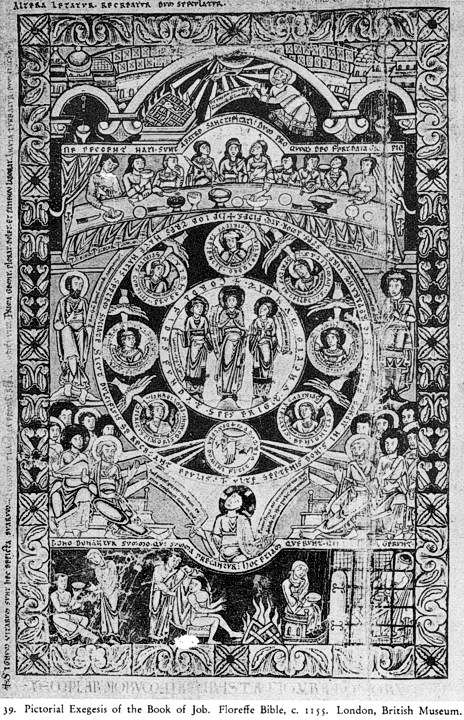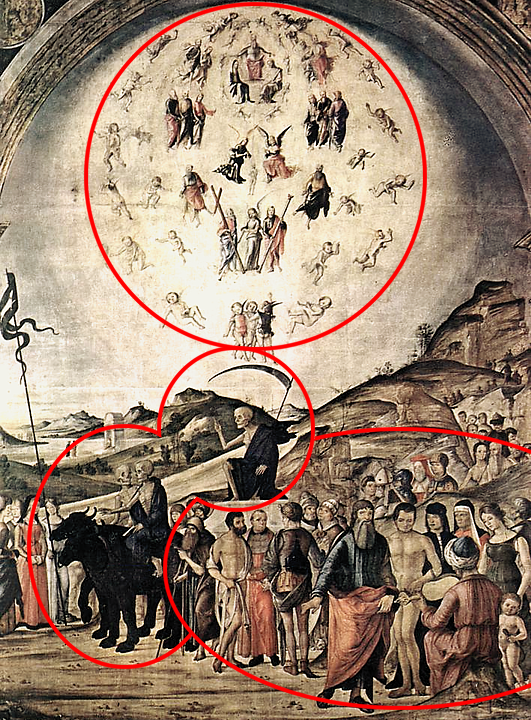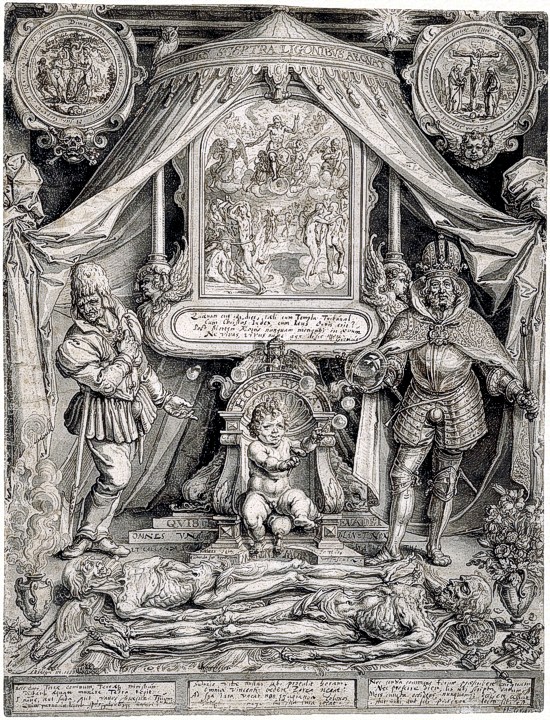Tarot as a Complex Allegory
Hi, Robert,
Newbies and clown-shoes poseurs think (or pretend) that we are starting from scratch with every discussion. They seem to believe that they are the first people to ever think about Tarot, so they just post their random thoughts as if the world really needs another brainstorming session among the ignoranti. It's a great time saver, as they don't need to learn anything before playing the game. However, the assumption that we're starting from zero with each new thread is false. Smart and knowledgable people have been learning, thinking, and writing about Tarot for a long time. First, the essays published in
Explaining the Tarot, for example, are among the few genuinely helpful attempts to explain the Tarot trump cycle. They are VASTLY more period appropriate than any story of Cathars.
Second, in the 19th century there were a number of playing-card historians who glimpsed (albeit vaguely) the
genre of the trump cycle as a whole. They compared the trump cycle to a
Danse Macabre, which in its most famous form (Holbein) has biblical scenes, a ranks of mankind, and personified Death. Third, in 1926, Arthur E. Waite's "The Great Symbols of the Tarot" was published in
The Occult Review. Waite categorized the trumps into four types of subject matter. In the first group he includes "Emperor and Empress, the Pope and Juggler", referring to them as representatives of "estates and types", a social hierarchy. He regarded a number of the cards as allegorical in the strict sense, such as Love, Death, Justice, Fortitude. Waite included a few cards (specifically the Devil and the Angel of resurrection), in the category of "doctrinal", referring to Christian eschatology. And finally, there were more than a few cards that he simply didn't understand at all, and chose to interpret "symbolically". These included the Popess, the Hanged Man, Chariot, Temperance, the Tower, the Star, the Sun and Moon, and the World. The Fool and the Wheel he considered complex and challenging.
With hindsight, the cards he assigned to the first three groups are all correct. Not coincidentally, these are the same three types of subject matter one finds in Holbein. The cards that he didn't understand, or wanted to redefine, were in some cases obvious. Temperance and the Wheel of Fortune, for example, are clearly allegorical subjects, conventionally represented. Waite admits the obvious "surface" significance of the Fool, belonging to the lowest estate, even while wanting to claim something more. Some of the so-called "symbolical cards", such as the Papess and Hanged Man, were identifiable historical images that Waite failed to recognize. Others, including the majority of the cards above the Devil, required a more systematic analysis than the card-by-card approach Waite took. But in general terms, he clearly had the right idea, and recognized three importantly different types of Tarot cards, as well as the catch-all category of "symbolical cards" for those he failed to recognize.
Fourth, in 1956 Gertrude Moakley's "The Tarot Trumps and Petrarch's
Trionfi" was published in
The Bulletin of The New York Public Library, and in 1966 her book was published. She discovered plausible readings for many of Waite's so-called "symbolical cards". These included the Papess as an unorthodox religious leader, (which Waite would have agree with, as the Secret Church), the Chariot as either Chastity (in V-S) or simply as a triumphal chariot, Temperance as Temperance, the Wheel of Fortune as the Wheel of Fortune, the Hanged Man as a traitor being executed, the Moon and Sun as elements of a larger design, (the Triumph of Eternity), and so on. The Tower and Star eluded her, but by the time her analysis was finished, these were really the only two cards left to decipher and categorize. Most of Waite's symbolical cards had been identified now as members of his other three categories. Not only were the subjects being identified and classified, but the classifications were in contiguous groups. The lowest ranking cards were *all* of the same kind, representatives of a social hierarchy. The highest ranking cards appeared to *all* be "doctrinal", eschatological in nature. And between the Pope and the Devil, the cards were *all* allegorical.
By this point, the trumps are not UFOs. (Unidentified Figurative Objects.)
This grouping into distinct sections of similar type is typical of the kinds of complex artistic programs typical of pre-Modern moral allegories. Over the years I have presented many examples of such allegories which combine representatives of Mankind, conventional allegorical subjects like Fortune, Death, and virtues, with biblical subjects -- sometimes from Genesis, sometimes from Revelation, sometimes from both. Even Bible illustrations sometimes included combinations of biblical and allegorical figures. An example I presented in the old
Riddle of Tarot page was the 12th-century
Floreffe Bible. Adolf Katzenellenbogen, (
Allegories of the Virtues and Vices in Mediaeval Art) explains how an illustration of Job's children unites several spheres of interpretation. Typologically, the seven sons of Job are related to the twelve apostles (3+4=7 and 3x4=12), while morally they are associated with the seven gifts of the Holy Spirit. Seven virtues which derive from these gifts (not the conventional seven Cardinal Virtues) are also shown, as are the three Theological Virtues, the latter associated with Job’s three daughters. Job, a type of Christ, prays for God’s mercy on his children, as Christ also pleads for them, and so on.
A great 14th-century example of such a complex cycle is the fresco at the Camposanto in Pisa. There is a Crucifixion on the south western side, then a Judgment scene on the southern side, Hell, then a Triumph of Death, and then the Egyptian hermits. Every section combines with the adjacent sections to amplify and elaborate the meaning of each. A detailed 15th-century example is presented in my series of posts on Costa's triumphs in the
Bentivoglio Chapel. The
Triumph of Fame panel includes the titular allegorical figure as well as representations of mankind, biblical scenes, historical scenes, and members of the patron's family. That is five (5) types of subject matter in one complex image, and that image is part of a cycle of two paired images (diptych), and part of a larger devotional complex. Cyclic art requires taking complexity and context into account.
Here is a pictorial summary of the
Triumph of Death panel, highlighting the three main types of subject matter: Mankind, Death, and the soul rising to Judgment. (This panel also includes members of the patron's family, under the banner of Chastity.)
At some point you should note that I'm not bullshitting. I'm not making stuff up. I'm not imagining what some hypothetical person might have done in some hypothetical circumstance for some hypothetical purpose. The people of that time and place made countless works of art and literature, and many of them have parallels in the Tarot trump cycle. Tarot is a unique work of art but not without parallels, and those parallels are
evidence of Tarot's meaning.
One of the earliest and most striking pictures related to this family of themes is a
Roman mosaic which combines symbols of the highest and lowest estates (representing all Mankind via merism), with symbols of Fortune and Death and, via the butterfly (Psyche) even the triumph over death. If you fail to recognize that the various symbols represent different types of subject matter then you cannot understand the design. This kind of complexity is a commonplace, and this kind of analysis of Tarot is reflected in the 16th-century essays and in Waite's 1926 article. Their insights can be built upon, if we don't pretend that we're the first ones to look at this question.
Getting back to the earlier writers whom we either learn from or disparage and ignore, our fifth instructor is Michael Dummett. His 1980
The Game of Tarot examined and compared all the historical sequences of Tarot Trumps. The previous studies by Waite and Moakley were iconographic, assessing the subject matter of the images. However, a very different kind of analysis was possible. By comparing the different historical sequences, looking for commonalties and variations, Dummett revealed exactly the same division of the trump cycle as earlier iconographic studies had suggested. As the order of cards was changed during Tarot's early spread, cards were moved about within each of the three groups, but not between them. Cards below the Pope were never moved above him, while cards above the Devil were never demoted below him. The single (apparent) exception to this was Justice, which in the Ferrara sequence was placed between the Angel of resurrection and the World, showing New Jerusalem. However, given a moment's reflection, it is obvious that the Moral Virtue of Justice had in fact been redefined into the eschatological Last Judgment, and the integrity of the groups remained intact.
While many Tarot enthusiasts seem to believe that historical facts are worthless, rejecting them without cause and even presuming to write a book on Tarot history without bothering to learn that history first, facts often do tell their own story... whether we like it or not. Dummett's analysis of the variations in trump order reveals, or confirms, the existence of three types of subject matter. In 1985, Dummett wrote "Tarot Triumphant", an article published in the periodical
FMR which precisely identified the three groups. "The individual subjects used for the trionfi appear to have been standardized early in the history of the pack; with few exceptions, all fifteenth century packs use the same set of subjects. The matto is not, strictly speaking, one of the trionfi.... The remaining twenty-one cards may be divided into three groups."
The first group consists of the "bagatella" (the "trifle", aka Mountebank or Magician) and the four "papal and imperial cards". Although not one of the trionfi proper, the Fool considered as an allegorical figure also belongs in this group, as the lowest of the lowly. These six cards are representative of the Ranks of Man, Waite's "estates and types", and show two representatives from each of the three estates of Medieval society. In every known ordering of the Tarot sequence, the Mountebank is the lowest of the trumps and the Pope is the highest. This clearly suggests that a meaningful design is present, even if the details are not obvious. A fool and a deceiver triumphed by an unorthodox religious leader, and the two highest Christian monarchs triumphed by the Pope, or else (in the Ferrarese order) the two representatives of each estate in order, commoners, nobles, and clergy. That is the place where subsequent analyses need to focus, figuring out the details.
Conversely, if you don't understand that didactic art routinely combined representatives of mankind, allegorical figures like Death personified, and biblical subjects from Genesis and Revelation, then you can't even understand something as simple and straightforward as Holbein's
Dance of Death. It begins with biblical scenes from Genesis, (as do all moral allegories, at least implicitly), then has dozens of allegories combining personified Death with representatives of mankind, and ends with an eschatological scene from Revelation, (as do all moral allegories, at least implicitly).
From your posts it is clear that this complexity is baffling to you, so I'll offer one more example, one of my favorites. This drawing is not technically a
Triumph of Death, although Death's triumph is at the heart of it. Rather than a personified Death, this allegory has a personification of Life, depicted as
Homo Bulla. The Reaper and Homo Bulla are combined in various works of art, including funerary art, and in the so-called Dutch Tarot,
Floskaartjes. Here, Homo Bulla takes the place of Death, making this a Vanitas rather than Triumph of Death, despite the floor being littered with bodies.
The title of the image,
Mors Sceptra Ligonibus Aequat, is a traditional memento mori subject. Death knows no rank -- Death equalizes the scepter and the spade, more or less. This is an ancient idea, precisely the same one illustrated in the Roman mosaic discussed above. (This is also an idea embodied in the trump cycle as well as all other
Triumph of Death works.) This print, however, shows an emphatically Christian version. The theme was discussed and illustrated in a series of posts in 2008, (
Mors Omnia Aequat,
Blunder and Bullshit, and
A Pair of Emblems), and this print was discussed in a more recent post from last year,
Complex Moral Allegories.
The content of the drawing is comprehensive, from Genesis through Revelation. This is the actual scope of all the
contemptu mundi works, although the biblical bookends are usually implicit. These works are all concerned with the triviality and enticements of the post-lapsarian world, which does little more than endanger one’s immortal soul. Why do we “remember death” or “remember the Last Things” (death, Judgment, Heaven, and Hell)? Why do we meditate on Homo Bulla, the idea that mankind’s lot in this life is a fragile and transient as a soap bubble? The answer is because of the economy of salvation, which refers to the Fall as described in Genesis (introducing sin and its punishment, death), Redemption in the Gospels (the Crucifixion and Resurrection), and the End Times in Revelation (the final triumph over the Devil and death itself). This is what matters, and mortal life -- life in this world as opposed to the next -- is nothing in comparison. Hence, the requirement for a studied contempt toward this world and a continuing focus on the next.
This particular print explicitly includes all the elements of the story. In the upper-left medallion we see Adam and Eve being deceived by the Snake. In the upper-right we see the sacrifice of the Crucifixion. In the large panel under the canopy we see resurrection, the Last Judgment, and souls assigned to Heaven and Hell. This is the biblical context of Death allegories, what made the vast art and literature of Gothic macabre meaningful to period audiences. In the lower half of the image we have the allegory per se. We see a monarch and a peasant flanking an enthroned Homo Bulla, with his traditional motto from the famous Hendrick Goltzius print,
Quis Evadet? No one escapes death, as surely as no bubble remains unbroken. The two figures, who combine to illustrate all the ranks of mankind, are shown below as corpses. Assorted other
Vanitas symbols decorate the scene, such as an owl (symbolizing night and death), smoke, flowers, and the implements of the two men are shown broken and ruined (
ubi sunt), under their dead bodies (
memento mori). It is a rich constellation of conventional elements neatly arranged: a schematic of life, death, and the meaning of it all.
I'll wrap this up in the next post.
Best regards,
Michael




